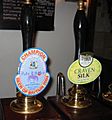Beer facts for kids
- Beer is also the name of a place in Devon, England - Beer (Devon)

Beer is a type of alcoholic drink. It is made using water, hops, barley (a type of grain), and yeast. Yeast is a tiny fungus that helps turn sugar into alcohol. This process is called fermentation. Fermentation also creates carbon dioxide, which makes beer bubbly.
Contents
What is Beer?
Generally, any alcoholic drink made by yeast turning sugar into alcohol, without using distillation, can be called a type of beer. For example, Japanese sake is made from rice using yeast. Even though some people call it "rice wine," it's actually a kind of beer.
How is Beer Made?
Making beer is called "brewing." It starts by mixing warm water with malted barley and other grains. Malted barley means the barley has been soaked and sprouted a little. Enzymes in the barley change the grains into simple sugars. This sugary mix is called the "mash."
Next, the liquid is drained from the grains. This liquid is now called "wort." The wort is boiled, and hops are added. Hops give beer its flavor and help keep it fresh. After boiling, the wort is cooled down.
Then, yeast is added to the cooled wort. The yeast eats the sugars and turns them into alcohol. This process changes the wort into beer.
Different Types of Beer
The ingredients used can change how a beer tastes. For example, an ale is made with yeast that ferments at higher temperatures. This yeast eats more sugar and makes more alcohol. A lager uses yeast that ferments at lower temperatures. This yeast eats less sugar, making a crisper and cleaner-tasting beer.
Adding more hops makes beer taste more bitter and smell stronger. Different types of cooked barley, called "specialty malts," create different flavors and colors. These flavors are very noticeable in dark beers like Porter and Stout.
Beer Laws Around the World
Countries have different rules for making beer. In Germany, Austria, Switzerland, the Czech Republic, and Slovakia, beer is often made only from hops, malt, water, and yeast. This was due to an old law called the Reinheitsgebot. This law was changed in 1992.
However, in Belgium, beers have always been made with other ingredients. These can include wheat, sugar, or even fruit.
How Yeast Affects Beer
The type of yeast used greatly affects the final beer:
- Some yeasts work best at warmer temperatures, usually between 15-20 °C (59-68 °F). They ferment quickly.
- Other yeasts prefer cooler temperatures, around 4-8 °C (39-46 °F). Beers made with these yeasts often last longer.
- Some beers ferment naturally from wild yeasts found in the air.
The History of Beer
The first records of beer date back about 7,000 years to the Sumerians. People believe the Sumerians accidentally discovered fermentation. An ancient Sumerian "Hymn to Ninkasi," the goddess of brewing, is also a recipe for making beer. This hymn, about 4,000 years old, describes making beer from barley and bread. It says the drink made people feel "wonderful and blissful." Some even think bread was first baked to make beer easier to carry. The Sumerians likely were the first to brew beer, seeing it as a special gift from the gods.
Alcohol in Beer
Most common beers have about 3-5% alcohol by volume. This means that in 100 milliliters of beer, there are 3-5 milliliters of alcohol. Brewers can easily change the amount of alcohol in beer. For example, adding more sugar before fermentation will lead to more alcohol. Today, beers can have anywhere from 2% to about 16% alcohol. This is similar to the alcohol content of wine.
Some beer labels say "alcohol-free," but this isn't always completely true. These beers usually have less than 1% alcohol.
Images for kids
-
Old English: Beore 'beer'
-
An ancient Egyptian model showing beer making, from the Rosicrucian Egyptian Museum
-
Malted barley before roasting
-
Kriek, a type of beer made with cherries
-
People sharing millet beer at a market in Mogode, Cameroon, 1998.
-
A tent at Munich's Oktoberfest in Germany. This is the world's largest beer festival.
See also
 In Spanish: Cerveza para niños
In Spanish: Cerveza para niños















